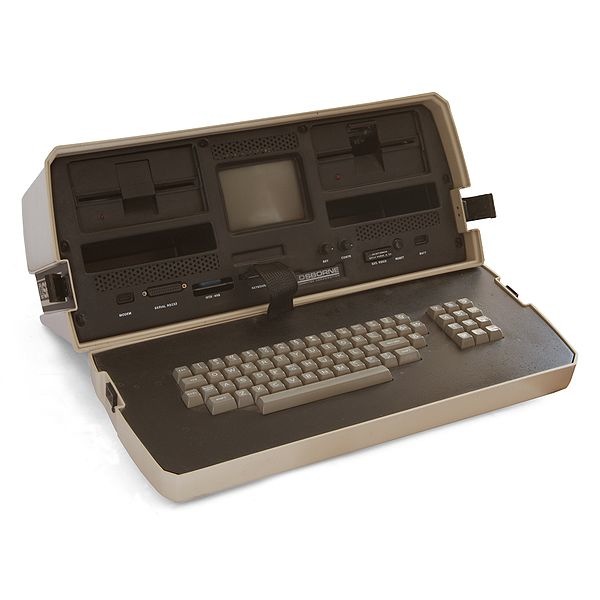Flashback to 1981.

The Osborne 1.
That’s a big claim, so let me step back a moment. The first personal computer which was actually usable by regular people was the Apple II, introduced in 1977. It cost some $2,500 plus lots more for a disk drive and software, appealed to a small cadre of visionaries – rich visionaries – and was out of my price range. When the Osborne I came along, it was some 100% cheaper than a loaded Mac and was quite perfectly ugly by comparison. Ostensibly portable, it would take a Schwarzenegger to justify that claim, for the Ozzy weighed in at 25lbs. Worse, it came with an awful 52 column by 25 row grey-on-black CRT display, quite unreadable to all but F15 pilots with 20-20 vision. So another $100 procured a 12″ green CRT display which was actually usable. The two disk drives were inept beyond belief, two single-sided 5 1/4″ floppy drives, each floppy storing but 360k of data. A few months later a 300 baud modem was made which slotted neatly into the fascia and provided dial-up access to …. well, not very much. I used The Source, a dial-up bulletin board which was great for exchanging use tips. The case, in cream plastic, was poorly made, the seams awful, and closing the box up was not a pretty matter. There was no battery – how much did you want to carry? – and the keyboard/cover was connected to the body with a broad and fragile ribbon cable.
Yet it was fabulous.
You what?
Simply stated, it came with the greatest package of software on earth. And that software was to be inextricably linked with my Unfair Advantage. Where others blew their coin on wine, women and song, I blew mine on what Steve Jobs famously called ‘A Bicycle for the Mind’. Man is a tool using beast, the feature which distinguishes him from other primates (OK, otters are pretty cool), and the Ozzy’s software cornucopia provided more leverage for the mind than Archimedes ever dreamt about.
The Ozzy sported a grand 16k of memory, a good chunk of which was taken up by the CP/M operating system, which had to be loaded from a floppy every time the machine was fired up. Hence the two floppy drives – one for the OS, the other for data. You would fire up the OS, then insert one of the software floppies to invoke the application of your choice. The bicycling mind still thought this was a great return on time invested.
And here’s the magic sauce. The software the Osborne came with still constitutes the bulk of my computer knowledge. It was outstanding in every regard.
The CP/M OS was superb – small, lean, fast, easy to learn as long as you were prepared to type commands on the one line command-line interface, confronted with a small flashing cursor which left everything to the imagination. When Microsoft’s DOS was introduced later, with the IBM PC, it was very much like using CP/M. I do not recall a lockup with either.
Once the OS was up and running, a minute or two of grinding from the left-hand floppy, you pulled the disc and installed one of Basic, Supercalc, Wordstar or dBaseII. What a thrill!
The obviousness of Supercalc, the second spreadsheet app after Apple’s Visicalc, was true magic once you got it. Learn how to input numbers and letters (‘strings’ in the Osborne’s arcane manual), input your first 2+2 calculation then change one of the cells to 3 and …. magic! 5 appeared on the screen. And while the spreadsheet has created more wealth destruction through its undisciplined interface, lacking all control and intellectual rigor, it was a ‘light bulb’ moment. Since then the spreadsheet has been the cause of insane, the tool for massive fraud by investment bankers back-solving for the desired input and continental depression, yet that ‘magic 5’ remains a moment I will never forget.
Continental depression? Why, yes. Just last week it was disclosed that two ‘esteemed’ economists – a contradiction in terms if there ever was one – funded by knuckle-dragging conservatives, had made fundamental formula errors in solving for their desired result. The conclusion from their spreadsheet? That Debt:GDP ratios exceeding 90% meant the end of the world. These ‘distinguished’ economists – two frauds named Reinhart and Rogoff – convinced western Europe that austerity was the only way out of the global recession. The only snag is, had they got their formulas right, they would have come up with a different answer and austerity would never have raised its ugly head, instead of ruining the economies of Great Britain, France, Portugal, Spain, Greece, Italy and so on. So yes, while the magic of the spreadsheet was immediately obvious, it was every bit as obvious that you could work that magic to get to any answer you wanted (investment bankers) or screw up royally and procure additional funding from your masters at the right-wing think tank (R & R).
The Basic app was outstanding. After mugging up on the language it was a simple matter to write your own routines to perform recurring calculations. Sort of a one cell spreadsheet. When the IBM PC came along a couple of years later the only software it shipped with was DOS and ROM Basic, the latter written by none other than Bill Gates himself, and it was what I used to codify bond math to a point where all the user had to do was input a variable and have the result appear instantly. A one cell spreadsheet calculator, if you like. The error, if any, was made at the coding stage, not at the calculation step.
Wordstar was a blast. For the first time I could write – and write copiously – and print the result to a 9 x 9 pin Okidata dot matrix printer. Trust me, that was a whole lot better than my handwriting. The wonderful Toshiba 24-pin variant came along two years later and suddenly dot matrix approximated the one-use carbon ribbon in the IBM ‘golf ball’ Selectric typewriter. Best of all, you could hack the source code with ease, though I still recall one evening when I was adding my own tailored commands to the menu only to come across the programmer’s invocation “You should not be looking here!” buried in the source code. Computing on the frontier was an absolute blast back then. And because you only had some 6k of memory left after the OS and Wordstar were loaded, Wordstar would permit near-infinite length documents by simply paging through them by swapping the contents of memory to that other floppy. Brilliant. Photoshop uses that technique to this day. And you could spread your magnum opus over as many floppy disks as your wallet could afford. Tolstoy would have loved Wordstar.
But all of those pale when it comes to applied rigor and discipline, and the name of this unforgiving teacher was dBaseII. dBase was originally written by Ashton Tate for the CP/M OS and it taught programming discipline like nothing else. Sure, you could carve out ‘if-this-then-that’ rules for special cases, but large populations of data hew to the rules of large numbers, with 80/20 rule sets very much at their core. You did not have to carve out too many exceptions when sorting through large data sets. I taught myself database programming using a book which profiled Fred’s Fish Shop, taking you thorough sales, inventory, receivables, payables and so on, all absorbed on daily commutes on the M104 bus in Mahattan on the way to work. Sure, the bus took longer to get to Wall Street than the RR subway from my Westside place, but it was air conditioned and the extra time was welcomed, dictating only that the alarm clock be set some 30 minutes earlier. When philosophical reflection on the plight of man was called for, all it took was a glance out of the window as the bus labored down Broadway, the passengers alternating between white, brown, yellow and black, then white again. The availability of a superbly powerful database management system for the price of the Ozzy was so overwhelming an economic proposition that I went out and bought Ashton Tate stock without a second thought. The return on that investment yielded my next computer, the first IBM PC.
The rest is history but the Ozzy can fairly be said to have been my greatest teacher ever.
Graphics User Interfaces? That was all much later. 1984 to be exact when the Macintosh arrived. And photo processing on a computer was a dream which did not see reality until 1990 with the introduction of Photoshop, only on the Mac! The first Nikon (not so) affordable scanners came along a few years later and suddenly all your images could be made digital and easily manipulated, be it Mac or PC. But that Ozzy, or more correctly, its software bundle, paved the way for this computer ingénu and all that followed.

The view east toward the MONY building, winter 1981,
as I learned dBase II on the Ozzy from my apartment
at 310 W 56th Street, New York City.
Leica M3, 50mm Summicron, Kodachrome 64.
The Ozzy passed to my niece at Champaign-Urbana, University of Illinois, upon which she wrote her dissertation which got her a first in brain studies. Or something. Way over my, err… head.
As an unsatisfied owner of Clive Sinclair’s ZX81, I was dreaming of the Osborne. Or of its competition with a larger, more useable screen, the Kaypro II. Later I settled for a lunch-box sized, display-less CP/M 80 machine.
IIRC, the Kaypro came out a couple of quarters after the Ozzy and was also a very capable CP/M machine – Ed.